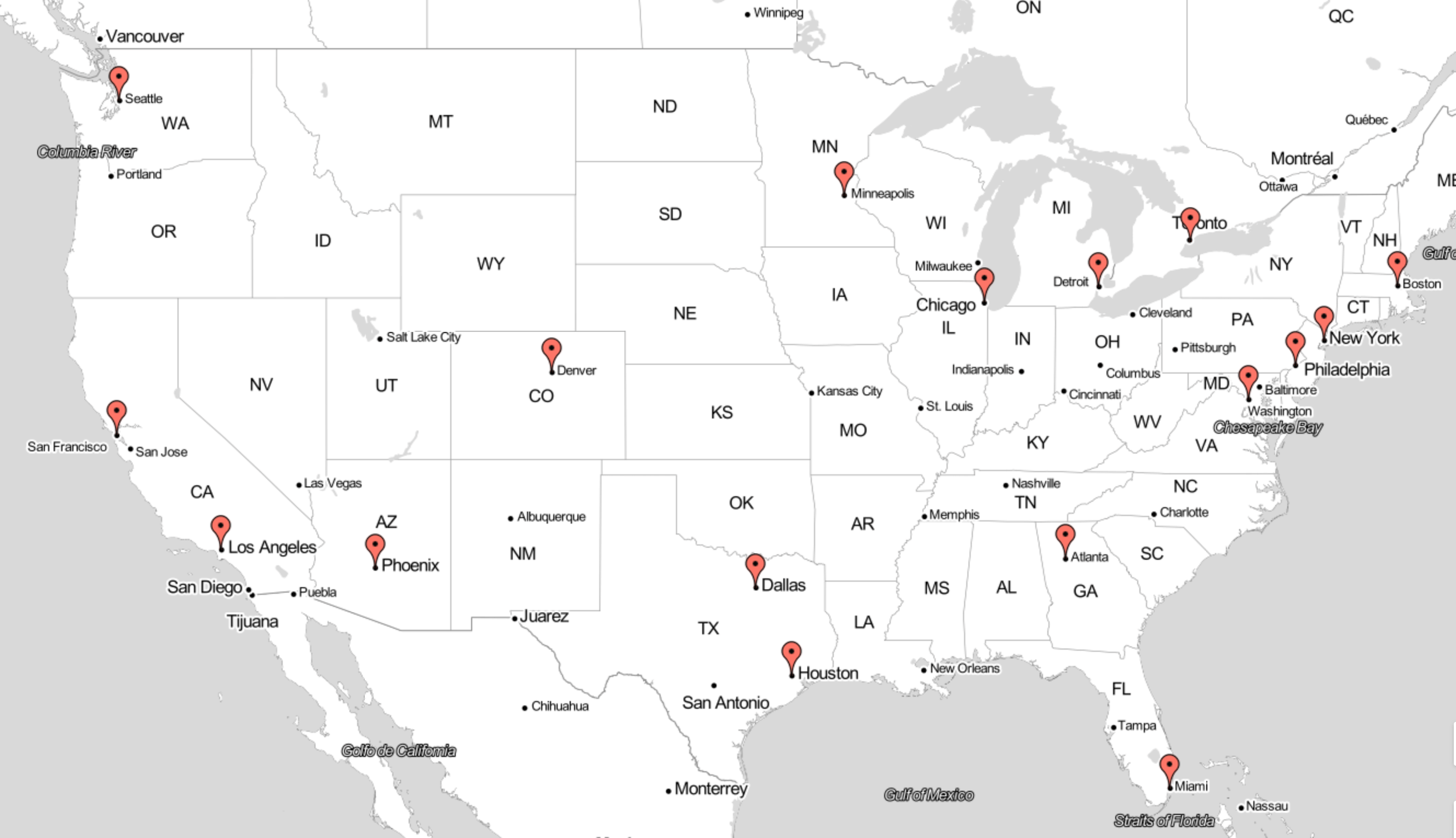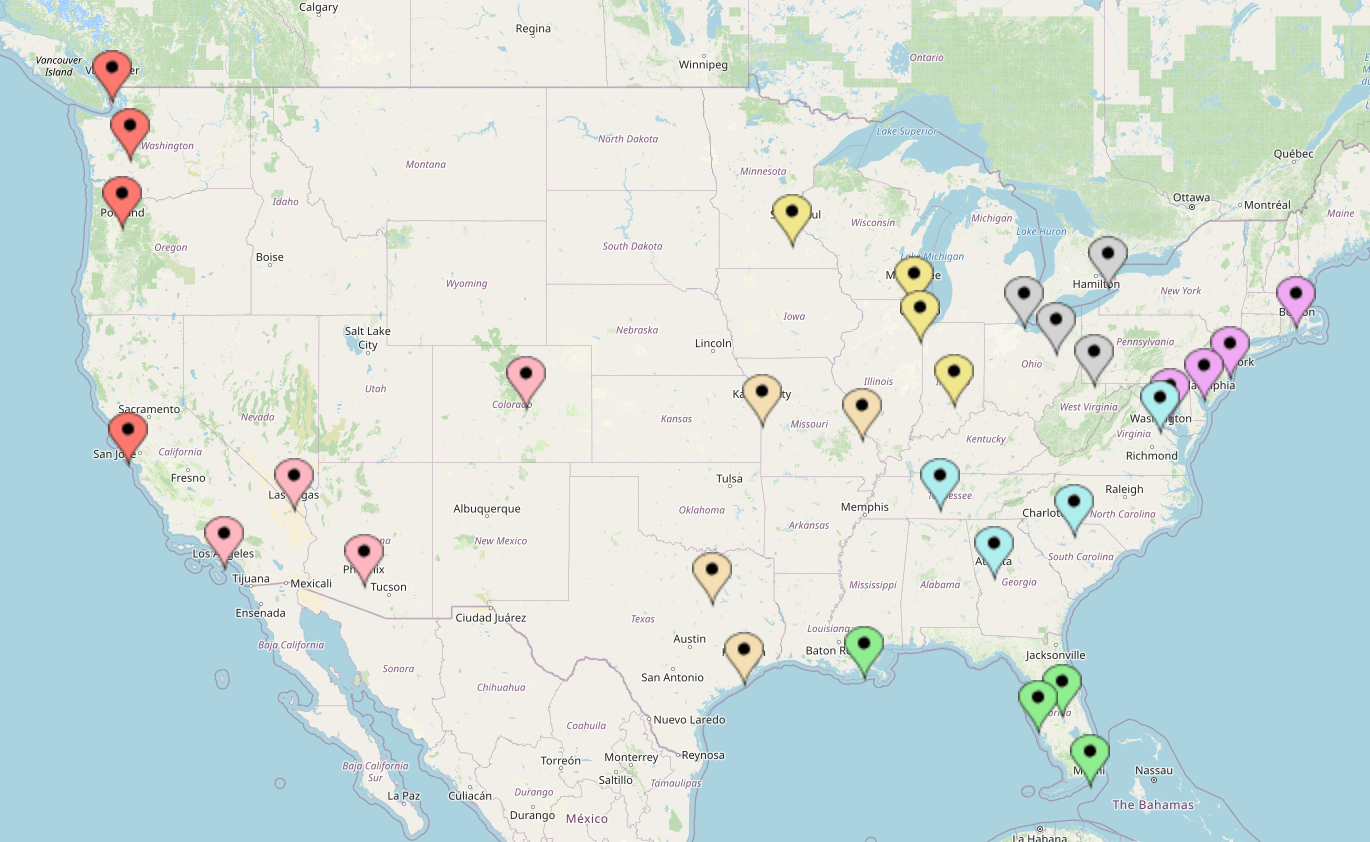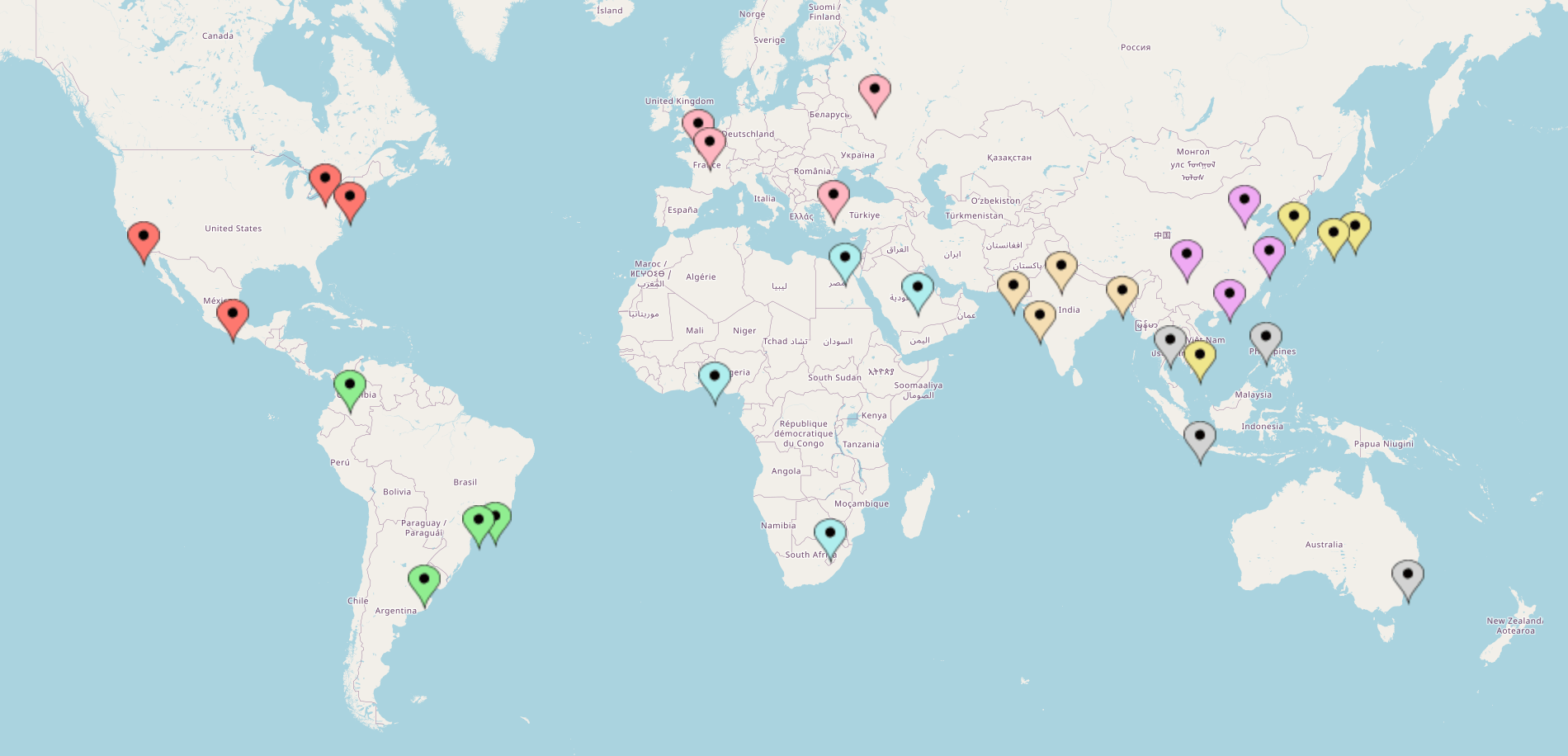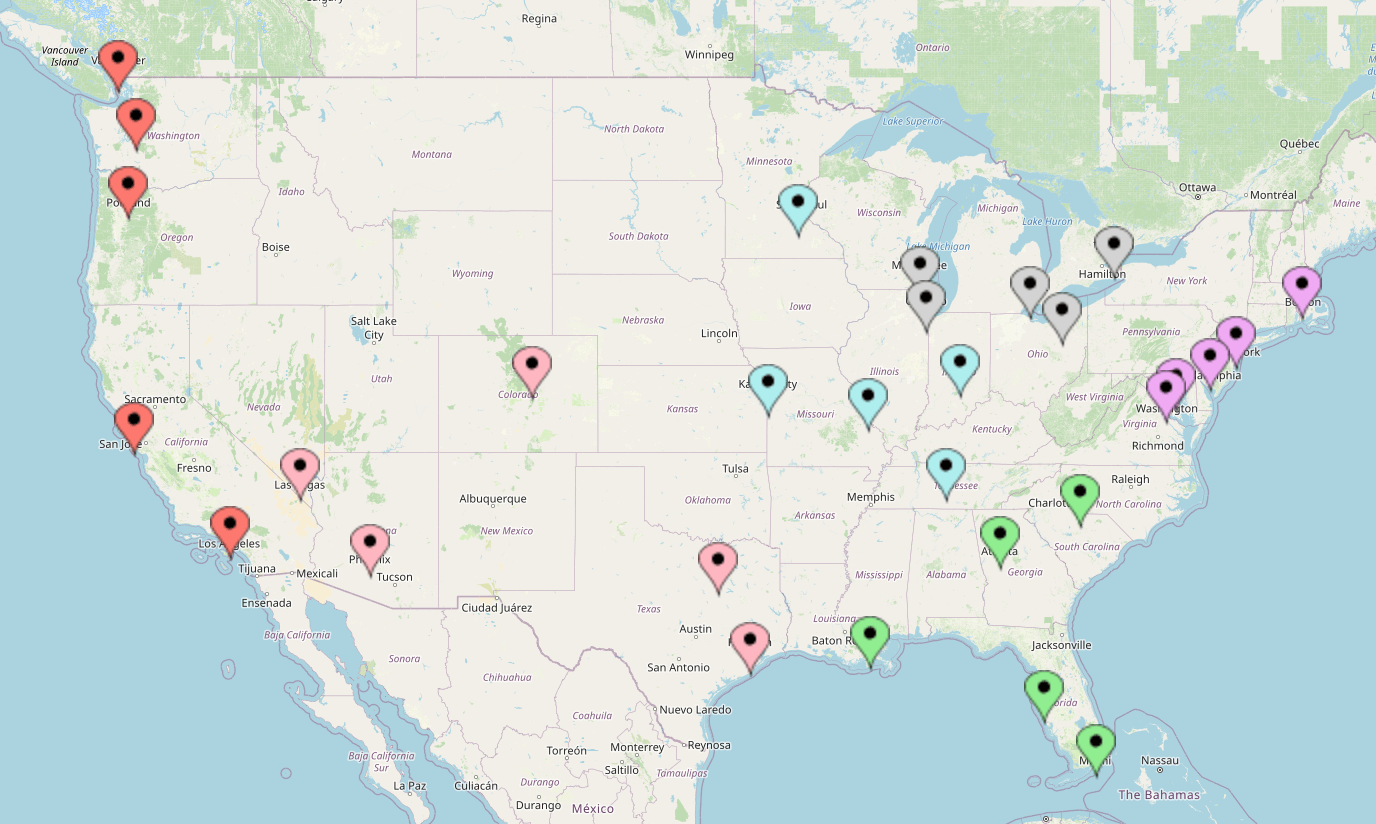send feedback
i like maps with cities on them to an extent that could be considered quirky. when i was 7 i got a big road map of the US with what i thought was an astonishing amount of cities on it. at the time i had a hobby of making up imaginary basketball teams,1 and i liked using maps to choose what cities all the players were from. this map expanded my pool of cities by ten or one hundred times. my favorite was abilene, texas; i think it has a very nice sounding name. it sounds like it would have been a popular baby girl name in 1960.
last time i was on a long flight, the screen on the seat before me had a button to show a map of what our plane was flying over. this was interesting, too, but not just as a list of cities where imaginary people could be from. i know almost all the big ones anyway. i think it’s interesting because it reveals which cities the map designers thought were important enough to be mentioned. you can see a similar thing on globes, or small printable maps, or if you zoom out just the right amount in an online map.
i assume the cities are either handpicked or decided by a computer program, but often i’m surprised by which ones get left out. it feels like gossip when i see los angeles omitted in favor of san diego, or denver omitted for salt lake city, or the bay area omitted in favor of sacramento. i’m disappointed anytime seattle’s not on there, but usually it is. and sometimes i’m amused to see a small city like billings, montana included just because there was nothing bigger to show in the area.
the main criteria for inclusion seems to be population, which makes sense. and printed maps often include every single capital city, but i prefer when they don’t. i prefer every decision to be personal.
maps also try to show a spread-out group of cities, most of the time. this is because two cities too close together can be hard to distinguish, and because two neighboring cities are probably similar enough that you don’t lose so much from omitting one. sorry, san jose. the converse of this is that mapmakers are loath to leave a big empty space. the viewer, when presented with this space, has an instinctive reaction: Hey! Mapmaker! Surely there are people there. Do they not matter to you?! then they start foaming at the mouth and they eat the mapmaker. so to avoid this the mapmaker will say, Yes of course, there are people living in siberia. several of them, in fact. then they will pick a town of population 4,000 notable for its proximity to a soviet-era coal mine, and the people will put down their weapons and learn to see the good in each other.
the geography aspect means that getting on the list is not just a matter of being an important enough city overall; a city’s appearance depends on its prominence relative to its peers. depending on the scale, seattle may compete with vancouver and portland, or it may be the juggernaut from which tacoma fights to distinguish itself. nice try, tacoma.
but the clearer competition between cities is for teams in major sports leagues.2 american sports leagues actually do have governing bodies to decide which cities are important enough to earn the privilege of a team. this is mostly based on TV market size, which is a combination of population, wealth, and competition for fans. some cities, like miami, are so important that they get a team in every league. some, like baltimore, get to play in a few leagues but not all of them. new york is so prominent it has two in every league, whereas oklahoma city contents itself with an NBA franchise that my mother will never forgive. some cities, like green bay, got in early and can’t move because of tradition; some states, like virginia, end up with an awkward lack because their cities are too similar in size, so they just have to resign themselves to the thought that washington DC is “close enough”.
to ease travel times, US sports leagues are split into conferences and usually divisions of nearby teams. each division is usually supposed to have the same number of teams, which leads to dubious placements at times, such as the dallas cowboys playing in the NFC east while the houston astros (houston is east of dallas) play in the AL west.
it’s always felt a bit weird to me that texas and seattle are both typically lumped into the “west”, even though they are so geographically and culturally distant. so we’ve finally reached the reason i made this post, which is that i looked through my notes and there was a folder with 8 different attempts at dividing US cities or world cities into sensible regions, i suppose in the event that a new sports league popped up and the commissioner asked me which 32 (or 30 or 48 or 60) major cities they should put teams in.
to challenge myself i put forth the following rules:
- 32 teams, split into two conferences which each have four divisions of four teams apiece.
- the conferences themselves should be geographic, like the NBA and MLS, and not have corresponding geographic divisions like the NFL and MLB.
- each team is a city; no city has two teams. i know that pro sports leagues don’t follow these rules, but i think it is elegant. i will not consider new york so special it gets a second team just for brooklyn, and i will not flatter st. paul by calling minneapolis’s team “minnesota”. it’s more pure.
- for the purposes of this challenge, canada is a US territory.
- population,3 wealth, TV market size, geography, and culture will all factor into the decisions.
the US
the US is relatively easier to figure out because this exact task has been attempted several times in the last 100 years. mostly they make geographical sense or cultural sense but not both, but in the 2010s there was one sports league that got it right. the five major regions of the US are: the Pac-12, the Big 12, the Big Ten, the ACC, and the SEC. there’s overlap, yes, but it’s more a reflection of reality than a flaw in the conferences. then there are smaller regions like the Mountain West, the MVC, the WAC, the Big South, the MAC, and so forth.
unfortunately, i’ve set out for a harder task than that of college football. i need divisions of equal size, and i need them to fit into conferences of equal size as well. so i can’t have an “alaska” division that’s 50 times smaller than the “eastern seaboard” division. so the big sky states, so named because they have no big cities to obstruct the sky, will get nothing. this makes it very clear which direction to proceed in the west (from the pacific northwest down the coast, then east), so i like to start there. as candidates i will reference the top 32 urban agglomerations, the top 32 TV markets, the top 32 cities by GDP, and any city with an NFL, NBA, or MLB team.
on all of the lists
New York, Los Angeles, Chicago, Washington D.C., Toronto, San Francisco, Philadelphia, Dallas, Houston, Miami, Atlanta, Detroit, Boston, Phoenix, Seattle, Denver, Minneapolis.
on at least two of the lists
Montreal, Vancouver, Cincinnati, Nashville, Las Vegas, St. Louis, Indianapolis, Pittsburgh, Columbus, Kansas City, San Antonio, Cleveland, Salt Lake City, Milwaukee, Memphis, New Orleans, Oakland, Orlando, San Diego, Tampa, Charlotte, Baltimore, Portland.
i will assume any city on all of the lists is a shoo-in. (NFL, NBA, and MLB are counted as separate lists, canadian cities aren’t excluded because of US-only lists, and sports teams that relocated in the last 20 years still count.) that leaves us with 17 shoo-ins and 23 contenders.

this is where geography and caprice come into play.
making the hard choices
the first division to shape up is the northwest. my preference is seattle, san francisco, portland and vancouver. this leaves us with four cities in varying stages of becoming san francisco. its counterpart the southwest has two obvious picks, los angeles and phoenix, and some questions. namely its geographic boundaries; is denver southwest? what about dallas? ultimately i think los angeles, phoenix, las vegas, denver is the most sensible grouping. some killer mexican food in there.
i think these divisions are both regionally and culturally coherent, but it gets a lot harder from here. probably doing 6 divisions of 5 would have been easier, but i never back down from a fight. so to help myself out i’m just going to cross off contenders that i can’t see myself placing anywhere. those are oakland, san diego, and salt lake city (missed the bus), plus montreal and columbus (lack of existing big 3 sports teams) and cincinnati and memphis (overshadowed by cleveland and nashville). that leaves only 25 cities for 24 spots in our great game of musical chairs.
i’ve decided that the midwest can be divided into three divisions: “great lakes”, “cowboy”, and “corn”. the cowboy division stretches from texas to missouri, including houston, dallas, kansas city, and st. louis. meanwhile corn is minneapolis, milwaukee, chicago, and indianapolis.6 finally great lakes can take detroit, toronto, cleveland, and… pittsburgh? close enough.
along the gulf of mexico, we already have miami, which is joined by tampa, orlando, and new orleans. miami, orlando, tampa, new orleans is a horrific humidity zone. the mid-east ends up with atlanta, nashville, charlotte, and washington, finally leaving us with the powerhouses boston, new york, philadelphia, and baltimore along the eastern seaboard. i don’t like splitting baltimore and washington, but it’s not much better to separate baltimore and philadelphia, so sacrifices must be made to keep the northeast to four cities.
that’s an entire league! if your city isn’t in it, then sorry but it sucks.
| west | east |
|---|---|
| seattle, san francisco, portland, vancouver | miami, orlando, tampa, new orleans |
| los angeles, phoenix, las vegas, denver | atlanta, nashville, charlotte, washington |
| houston, dallas, kansas city, st. louis | detroit, toronto, cleveland, pittsburgh |
| minneapolis, milwaukee, chicago, indianapolis | boston, new york, philadelphia, baltimore |

i think this is pretty decent, but i somewhat prefer the alternate version i made with 6 divisions of 5 teams, seen in this footnote.7
stage 2: the world
now that was easy mode! compared to the world, the US is quite homogeneous and stable. but when other countries are thrown into the mix, we have some more questions:
- how do we deal with cities/countries that are much wealthier than others with the same population?
- how do we deal with countries that are just huge?
- what about countries that are right next to each other but also happen to be political enemies?
- how does the coriolis effect play into all this?
my answers are the following:
- wealthier places get more teams. i think the quality of sports teams in africa is indicative: some countries have ok national teams (like, borderline top 20 in soccer), but the very best club teams are nowhere near the level of top club teams from other continents, except maybe oceania.
- while china and india are each about one-fifth or one-sixth of the world’s population, i think no country should have more than one division’s worth of teams.
- prefer not to
- this remains one of science’s greatest mysteries
unfortunately, there are not many actual leagues to use as inspiration. no one really does global sports leagues, because travel is impractical and most sports don’t have more than one top-notch continent anyway. the only city-based global sports league i know of is Overwatch League. but fortunately, the world lends itself more easily to macro level analysis. the main question is: how many cities should each region get?
i think it’s believable that a sports league could have half or more of its teams come from the united states. (overwatch league does or did, i think.) the US has 11 of the 22 highest-GDP cities in the world, and canada has one. but these two countries only have 10 of the 81 most populous cities in the world. (why do they stop at 81?) given that the americas compose about an eighth of the world’s population and a third of the world’s GDP, i’ll go somewhere in the middle and give it a fourth of the teams (two divisions). this means the other two divisions in its conference must be across an ocean, from which i choose the atlantic. that means europe and africa, and maybe continuing farther into the middle east.
to answer the question of how far east our first conference goes, we first have to confront the elephant in the room: how much does asia get?
logistically i think the answer has to be 4. if you do 5 then you have a conference spanning from los angeles to, like, pakistan, which is a bit much. 5 better corresponds to the population numbers but GDP is more like 3 or 4 depending on whether you adjust for PPP.8
having settled on 4, i think it’s reasonable to subdivide into: east asia, most or all of china, southeast asia + oceania, and south asia. then you’re left with europe, africa, and the middle east. (“EMEA” as the business folks call it.)
africa is a tough question, as discussed earlier, because it’s big but poor. none of its cities rank in the top 100 by GDP; manchester, england has a higher GDP than any of them. the middle east is similarly tough, because it’s not all that populous and not all that wealthy, and the wealthiest cities are mostly not that big and just have a ton of oil revenue.
i think as a balance of wealth and population, plus for the overall sensibility of geography, one division should be africa + middle east and one division should be europe. there is more litigation to come on where europe ends and the middle east begins, but we will get to it.
auto-includes
to help ourselves out, let’s make a list of cities that absolutely must be on the list. i’m not going to use methodology quite as scientific, but the criteria “is huge”, “is economically productive”, and “is a powerhouse city in its region”. those are:
New York, Los Angeles, Mexico City, Sao Paulo, Rio de Janeiro, London, Paris, Moscow, Istanbul, Cairo, Delhi, Beijing, Shanghai, Tokyo, Seoul, Bangkok, Jakarta, Manila.
this is 16 cities, leaving us 16 more to go. let’s fill them in division by division.
making the hard choices
the first hard choice is, are the americas NA/SA or NA/latin america? that is, should mexico city be north or south? culturally it could go either way, economically it should be south, but by population it should be north. ultimately i will defer to the fact that mexico is not in the south american division of any international sporting competition, and thus i will place it in north america. our remaining city could sensibly be chicago or toronto, but we don’t have a canadian city yet so i will go with new york, los angeles, toronto, mexico city.
for south america, i’ll just take the next two biggest cities because culturally it all fits pretty well. that gives sao paulo, rio de janeiro, buenos aires, and bogota.
for europe/africa, the burning question is: is istanbul european or middle eastern? because if it’s middle eastern, europe gets 4, and if it’s european, africa+middle east gets 4. while europe has more cities that could realistically house world-class sports teams, the result was just stupid. so europe will have to be happy with london, paris, istanbul, moscow. now with africa i have 3 pretty solid cities and then a lot of small-but-somewhat-wealthy and large-but-very-poor ones. kinshasa misses the cut on account of being in the democratic republic of the congo, tel-aviv misses the cut on account of being small and also could you imagine that?, dubai misses the cut on account of fuck dubai, etc. so in the end i accepted an undisclosed sum from the owner of al-hilal and chose cairo, lagos, johannesburg, riyadh. culturally and geographically this is a stretch, but that’s the nature of the challenge. and really the alternative to stretching it is leaving some subregions out.
for asia i’m actually going to start with southeast asia + oceania, because it’s actually really easy. bangkok, jakarta, manila, sydney. ok we’re done.
the big question now is china, because if we’re being honest it has the population and wealth to support like 6 teams. it’s about three times as populous and wealthy as all of south america combined. but there are way too many other important cities to give china 6. so we’ll do 3 or 4. the next question is how to arrange them.
to help decide on this, let’s add a couple more to our list of auto-include cities. i deem our new list to be: Tokyo, Seoul, Beijing, Shanghai, Guangzhou, Delhi, and Mumbai. and the borderline cities, which i will list alongside their population rank and GDP rank, are Chengdu (27/42),9 Ho Chi Minh City (25/141), Dhaka (13/91), Osaka (26/8),10 Karachi (22/64), and Kolkata (15/215). the good news is i only have to exclude one of these. and for the sake of coherence within regions i’m going to exclude kolkata. yes this does put pakistan and india into the same region, but i’m sure they can learn to appreciate each other through the power of great sportsmanship :)
the 3 regions that will be formed from those shall combine with the already-determined ones to give us:
| west | east |
|---|---|
| new york, los angeles, toronto, mexico city | tokyo, osaka, seoul, ho chi minh city |
| sao paulo, rio de janeiro, buenos aires, bogota | beijing, shanghai, guangzhou, chengdu |
| london, paris, istanbul, moscow | karachi, delhi, mumbai, dhaka |
| cairo, lagos, johannesburg, riyadh | bangkok, jakarta, manila, sydney |

stage 3: what now?
well the answer is obvious. we start calling up execs and we make things happen. does anyone have mark cuban’s phone number
-
it can hardly be a surprise that i later got into sports management video games; at that age, i was into imaginary sports players more than i was even into video games. i think i made 21 basketball teams before losing interest. sometimes i would pretend to play matches between them using different colored marbles. they were fancy plastic marbles that you were supposed to be able to connect together with plastic sticks, but i ignored the sticks almost entirely. ↩
-
this mainly applies to US franchise sports; non-US leagues tend to have promotion and relegation, which makes membership in the top league dependent on the merits of the team and not the city. ↩
-
note that i do not mean the typically cited “city-limits” population estimates. these would have you believe los angeles has only 3 million people, jacksonville is the largest city in florida, and albuquerque is bigger than boston. these are artifacts of some cities drawing their city limits really wide while some draw them really small. and for sports purposes, suburbs count as part of the city. (up to a point, seahawks fandom gets more intense the farther you get from seattle proper.) anyway what i will use instead is called “urban agglomeration”–basically, the contiguous area that is at least dense enough to count as a suburb. ↩
-
as a side note, while i believe no conference realignment of the last ten years has been a good change, i think it’s hilarious that two of the three major conferences to emerge from the rubble are have been stuck for years with an incorrect number in their name. and they could have rebranded easily like the Pac-12 did, except that they both chose the exact same format as each other. ↩
-
Conference USA and the AAC are omitted by intention. ↩
-
i recognize that these cities miss most of the actual US corn-growing region, but it’s the closest available and i couldn’t help myself ↩
-
the alternate divisions if we go 6x5:
 ↩
↩ -
PPP is ‘purchasing power parity’. basically regular (aka nominal) GDP measures, “how much could you afford to buy if you lived in the united states,” whereas PPP adjusted GDP measures how much you can afford to buy where you live. because the same goods tend to be cheaper in poorer regions. ↩
-
about five other chinese cities could be borderline, but i have decided chongqing will be the fourth one it gets because of its size and its coverage of a slightly different region of china. like i could include shenzhen, but i already have guangzhou so why bother. ↩
-
by this i don’t mean just osaka but the whole urban area around it, including kobe and kyoto. japan is awkward because it doesn’t quite have the population to justify two cities out of 32, but its two major urban areas are humongous. and rich. ↩